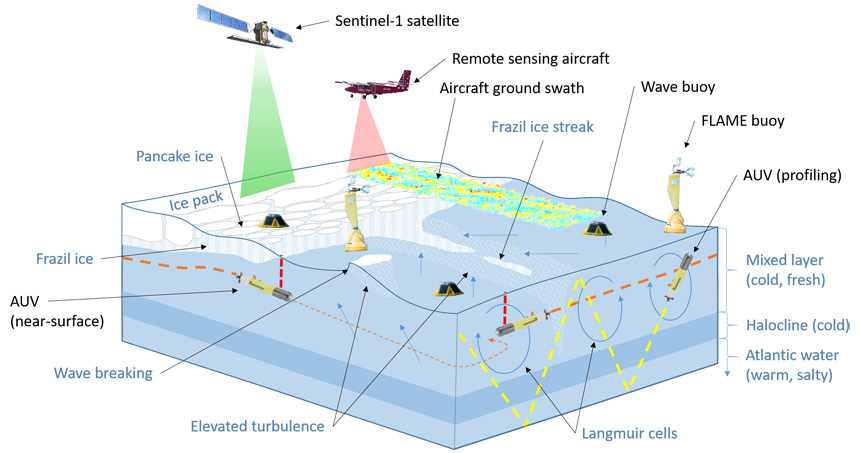
Here are descriptions of a few of my ongoing research projects:
Wave-modulated Arctic Air-sea eXchanges and Turbulence (WAAXT)
WAAXT is a project funded by the European Research Council (ERC) to improve our understanding of ocean boundary layer processes in a changing Arctic Ocean. Sea ice extent in the Arctic Ocean has been decreasing since the beginning of the satellite era, meaning that open-water, as opposed to under-ice, oceanographic processes are becoming increasingly important for Arctic dynamics. One of the most fundamental differences between the open and ice-covered oceans is the presence of surface waves. Surface waves and wave-driven processes drastically alter air-sea fluxes, upper-ocean turbulence, and the dominant dynamical balance in the upper ocean.
WAAXT is based on a series of process studies using remote sensing and in situ autonomous platforms to study the physical processes associated with this emerging wave climate, with a particular focus on near-surface turbulence. Three major effects of wave processes will be targeted:
- Modification and suppression of ice formation by wave motions and the associated elevated near-surface turbulence.
- Physical breakup of sea ice by wave motions, and the associated contributions to the modification of air-sea fluxes, upper-ocean structure, and melt rates.
- Interactions between wave-driven turbulence, especially wave breaking and Langmuir circulations, with the unique salinity-based stratification in the Arctic basin.
A key aspect of these processes is their horizontal variability, which will be captured using a multi-platform approach. Experimental work will begin in a natural laboratory in the Saint Lawrence Estuary (see below) and move to the Arctic as scientific and technical capacity is developed.
The long-term goal for WAAXT is to produce the data and parameterizations needed to understand climate-scale feedbacks associated with the emerging wave climate in the Arctic basin.

General configuration of multi-platform process studies designed for WAAXT. The “nested” sampling strategy allows small-scale physical processes to be linked to larger-scale wave and ice conditions using airborne and satellite remote sensing. The sampling strategy covers scales of centimetres to hundreds of kilometres.
Financed by:

CNES – WAVE-ICE
Due to the importance of the polar wave field, particularly in the marginal ice zone (MIZ), an all-weather, long-term, wide-area monitoring system is desirable. Satellite-borne synthetic aperture radar (SAR) has the potential to provide such observations. Recent work has shown that wave fields can reliably be extracted from Sentinel-1 SAR imagery. The goal of this project is to calibrate and validate the SAR wave retrieval algorithms with in situ measurements so that SAR can be used generally for wave retrieval in the MIZ, and so that any differences in retrieved wave spectra are understood. Related to this activity are more general scientific questions regarding wave energy attenuation in the MIZ that can be addressed using the combination of in situ and satellite observations.
WAVE-ICE has resulted in the following publications:
-
Sutherland, P., and D. Dumont, 2018. Marginal ice zone thickness and extent due to wave radiation stress. Journal of Physical Oceanography, doi:10.1175/JPO-D-17-0167.1
-
Stopa, J. E., P. Sutherland, and F. Ardhuin, 2018. Strong and highly variable push of ocean waves on Southern Ocean sea ice. Proceedings of the National Academy of Sciences, doi:10.1073/pnas.1802011115
-
Sutherland, P., J. Brozena, W. E. Rogers, M. Doble, and P. Wadhams, 2018. Airborne remote sensing of wave propagation in the marginal ice zone. Journal of Geophysical Research - Oceans, doi:10.1029/2018JC013785
-
Zippel, S. F., T. Maksym, M. Scully, P. Sutherland, and D. Dumont, 2020. Measurements of enhanced near-surface turbulence under windrows. Journal of Physical Oceanography, 50, 197-215, doi:10.1175/JPO-D-18-0265.1
WAVE-ICE also laid the scientific and technical foundation for the ERC project WAAXT (above).
Financed by:

St. Lawrence Natural laboratory

Since 2016, I have been participating in the development of a natural laboratory in the Lower St. Lawrence Estuary for studying sea ice processes in a relatively controlled and accessible manner. This is a project initiated and led by Dany Dumont at UQAR-ISMER.
The experimental site is located in and around the Baie du Ha! Ha!, in the Parc National du Bic, Quebec, Canada. Baie du Ha! Ha! is a 1x2 km bay open to direction of prevailing wind events in the region. Although most of the estuary is covered by ice in the winter, tidal mixing keeps a large section surrounding the experiment site, ice free year round. At the same time, because of its geometry Baie du Ha! Ha! itself typically fills with ice. This means that our ice-covered experiment site is directly exposed to waves that develop over 80 km of open water, making it a perfect location for studying the interactions of waves in sea ice.
The location was chosen, in part, due to the presence of a nearby hill which allows us to mount time lapse cameras overlooking the bay in order to study ice evolution. The bay is also instrumented with bottom pressure sensors and an ADCP. Daily excursions with an ice canoe are then used to deploy wave measurement buoys, additional ADCPs, and to make in situ ice measurements. Airborne imagery from UAVs is also used.
So far, our collaboration has resulted in these papers:
-
Sutherland, P., and D. Dumont, 2018. Marginal ice zone thickness and extent due to wave radiation stress. Journal of Physical Oceanography, 48, 1885-1901, doi:10.1175/JPO-D-17-0167.1
-
Zippel, S. F., T. Maksym, M. Scully, P. Sutherland, and D. Dumont, 2020. Measurements of enhanced near-surface turbulence under windrows. Journal of Physical Oceanography, 50, 197-215, doi:10.1175/JPO-D-18-0265.1
The use ice canoe has been a key aspect to the success of this work. Ice canoes allow safe, low cost, access to sea ice. Their light weight hull is designed to skim across the surface of ice and water, rather than plowing through it. Unlike ice breakers, ice canoes do not damage the ice that they traverse, allowing us to make measurements of sea ice processes in their natural state.
Surface breaking waves
When wind flows over the open sea, it creates surface waves. Most of the energy and momentum flux between the atmosphere and ocean passes through that wave field. Although some of this energy and momentum can be transported thousands of miles away by swell, the majority is injected locally.
Breaking surface waves, the “whitecaps” that can be seen on the sea surface any breezy day, are important. They are the dominant mechanism for wave energy dissipation and for momentum transfer from waves into mean currents. However, breaking is a complex nonlinear process with important physical scales (time and space) ranging over several orders of magnitude. This makes numerical modelling very difficult and actual measurements necessary.